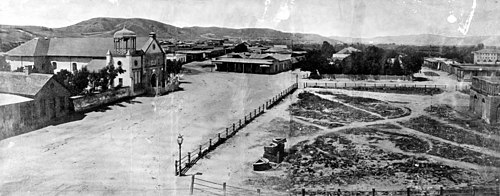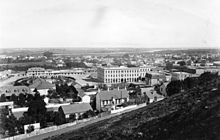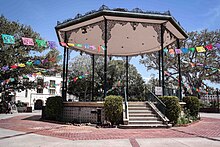| Revision as of 14:59, 2 August 2014 editRosiestep (talk | contribs)Autopatrolled, Administrators304,990 edits c/e; headers← Previous edit | Revision as of 00:44, 4 August 2014 edit undoRevent (talk | contribs)Extended confirmed users, Pending changes reviewers16,955 edits Removal of extensive content plagarized directly from cited public domain source. Misplaced Pages:PLAGARISM#Public-domain_sourcesNext edit → | ||
| (One intermediate revision by the same user not shown) | |||
| Line 1: | Line 1: | ||
| ] | ] | ||
| '''Los Angeles Plaza''' is located in ], ], US. It is the central point of the ]. | |||
| '''Los Angeles Plaza''' is located in ], ], US. It is the central point of the ]. When Governor ] founded the ], his first act was to locate a plaza for the geographical center from which his town should radiate. De Neve’s plaza was rectangular in form—75 varas wide by 100 in length. It was located north of the church; its southerly line very nearly coincided with the northerly line of West Marchessault street. On this, the ''cuartel'' (guard house), the public granary, the government house and the ''capilla'' (chapel), fronted.<ref name="TheSociety1898">{{cite book|author1=Historical Society of Southern California|author2=Pioneer Register, Los Angeles|title=Annual Publication of the Historical Society of Southern California and Pioneer Register, Los Angeles|url=http://books.google.com/books?id=FoAyAQAAMAAJ&pg=PA247|edition=Public domain|year=1898|publisher=The Society|pages=247–}}</ref> | |||
| ==18th century plaza== | ==18th century plaza== | ||
| Line 10: | Line 11: | ||
| ] | ] | ||
| ] | ] | ||
| In 1814, when the foundation of the ] was laid, it, too, fronted on the old plaza; but the great flood of 1815 changed the ]’s channel from the eastern side of the valley to the western and the waters came up to the foundations. The location of the church was changed to higher ground—its present site. When the final location of the Nueva Iglesia had been decided upon by Gov. Sola in 1818, next in importance was a plaza on which the church should front and since there was none, the evolution of plaza from the ''ejidos'' or common land and house lots began. There were evidently some buildings on the designated area, for old records note that the pueblo authorities, in 1825, ordered a house torn down that stood on the plaza.<ref name=TheSociety1898 /> | |||
| Previous to 1818, the trend of the pueblo’s growth had been to the northward, but after the location of a site for the new church had been determined the movement to the southward began. June 21, 1821, ], one of the aristocrats of the ancient pueblo regime, petitioned the Comisionado for a house lot near the “new temple which is being built for the benefit of our holy religion.” A lot 40x60 varas (the present site of the ]) was granted him. On this lot between 1821 and 1823 Carrillo built, for that time, a notable residence, ], fronting it on the plaza. Plaza fronts became the fashion with the pueblo aristocracy; and in course of time the homes of the Picos, the Carrillos, the Sepulvedas, the Olveras, the Lugos, and the Abilas were clustered around the square.<ref name=TheSociety1898 /> | |||
| There seems to have been no “plano” or plot made of the new plaza. The building line zigzagged. A moderate deviation was not noticed, but if someone built out too far, the authorities pulled down his residence. In 1838, the city authorities ordered Santiago Rubio’s house demolished “to maintain the Plaza line.” When the vacant lots with Plaza fronts were all built upon, the irregular shape of what was originally intended to be a square became more noticeable. So the Ayuntamiento (Council) set to work to solve the problem of squaring the Plaza, but it proved to be a difficult problem. Commissioners were appointed and they labored faithfully to evolve plans to remedy “certain imperfections which have been allowed to creep into the form of the Plaza through carelessness; and to add to the beauty of the town by embellishing the Plaza.” But they encountered opposition to their efforts.<ref name=TheSociety1898 /> | |||
| Pedro Cabrera’s house lot fell within the line of a street that it was proposed to open out to the westward from the Plaza. The Commissioners offered him a larger and better lot in exchange, but Pedro declined the offer. He wanted a Plaza front and the new lot had none. Then the Commissioners offered him another lot and for damages the labor of the chain gang for a certain number of days. But Pedro was inexorable, so the street had to take a twist around his lot, and the twist gave the Calle Iglesia (Church street), now West Marchessault. By reducing its dimensions and by giving the lot owners who had built back the land between them and the new building line the Ayuntamiento succeeded in partially squaring the Plaza. The north, south and west lines, after squaring, were each 134 varas or about 380 feet in length and the east line was 112 varas or 330 feet long. At that time ] (or Vineyard street, as it was then called) ended at Arcadia Street and the principal entrance into the Plaza from the south was the Calle de Los Negros.<ref name=TheSociety1898 /> | |||
| During the time of Spanish and Mexican domination in California, the Plaza was a treeless common; its surface pawed into ridges or trodden into dust by the hoofs of the numerous mustangs tethered on it or ridden over it. It had, however, its annual spring cleaning and decoration for the festival of Corpus Christi. For a decade or more after the American occupation its appearance was unchanged. The first attempt at its improvement was made by the city authorities in 1859. It was enclosed by a picket fence, walks were laid off and some shrubbery planted. But in those days the city exchequer was in a chronic state of collapse and the improvements made were not kept up. The Plaza gradually lapsed into its former state of dilapidation. On July 22, 1868, the city of Los Angeles entered into a contract with John S. Griffin, P. Beaudry, and Solomon Lazard for a thirty years’ lease of the city water works.<ref>{{cite web|title=CITY OF LOS ANGELES, Herman Silver, Z. D. Matthuss, et al., Appts., v. LOS ANGELES CITY WATER COMPANY, Crystal Springs Land & Water Company, and S. G. Murphy.|url=https://bulk.resource.org/courts.gov/c/US/177/177.US.558.148.html|publisher=Public.Resource.Org, Inc. (US)|accessdate=2 August 2014}}</ref> |
During the time of Spanish and Mexican domination in California, the Plaza was a treeless common; its surface pawed into ridges or trodden into dust by the hoofs of the numerous mustangs tethered on it or ridden over it. It had, however, its annual spring cleaning and decoration for the festival of Corpus Christi. For a decade or more after the American occupation its appearance was unchanged. The first attempt at its improvement was made by the city authorities in 1859. It was enclosed by a picket fence, walks were laid off and some shrubbery planted. But in those days the city exchequer was in a chronic state of collapse and the improvements made were not kept up. The Plaza gradually lapsed into its former state of dilapidation. On July 22, 1868, the city of Los Angeles entered into a contract with John S. Griffin, P. Beaudry, and Solomon Lazard for a thirty years’ lease of the city water works.<ref>{{cite web|title=CITY OF LOS ANGELES, Herman Silver, Z. D. Matthuss, et al., Appts., v. LOS ANGELES CITY WATER COMPANY, Crystal Springs Land & Water Company, and S. G. Murphy.|url=https://bulk.resource.org/courts.gov/c/US/177/177.US.558.148.html|publisher=Public.Resource.Org, Inc. (US)|accessdate=2 August 2014}}</ref> | ||
| ==Los Angeles Plaza Park== | ==Los Angeles Plaza Park== | ||
Revision as of 00:44, 4 August 2014

Los Angeles Plaza is located in Los Angeles, California, US. It is the central point of the Los Angeles Plaza Historic District.
18th century plaza
The 18th century plaza viejo (old plaza) predates the 19th century plaza nuevo. The old plaza of El Pueblo de Nuestra Sonora, La Reina de Los Angeles (the town of our Lady, the Queen of the Angels) as decreed by Gov. Felipe de Neve in his "Instruccion para La Fundaccion de Los Angeles" (26 August 1781), was a parallelogram one hundred varas in length by seventy-five in breadth. It was laid out with its corners facing the four winds or cardinal points of the compass, and with its streets running at right angles to each of its four sides, so that no street would be swept by the wind. Two streets, each ten varas wide, opened out on the longer sides, and three on each of the shorter sides. Upon three sides of the plaza were the house lots, 20x40 varas each, fronting on the square. One half of the remaining side was reserved for public buildings—a guard house, a town house, and a public granary; the other half was an open space. Around three sides of the old plaza clustered the mud-daubed huts of the pioneers of Los Angeles, and around the embryo town, a few years later, was built an adobe wall—not so much perhaps for protection from foreign invasion as from domestic intrusion. It was easier to wall in the town than to fence in the cattle and the goats that pastured on the ejidos or commons, outside the walls. The boundaries of the plaza viejo, as nearly as it is possible to locate them, are as follows: The southeast corner of the plaza would coincide with the northeast corner of Marchessault and Upper Main streets. From the said northeast corner of these streets draw a line land boundaries were of rare occurrence and title deeds when given were loosely drawn. The more or less in a conveyance never worried the party of the second part. In the minutes of the ayuntamiento may be found the grant of a certain piece of land now known as the Requena tract which is described and deeded as that lot or tract on which the "Cows ate the apples".
19th century plaza




During the time of Spanish and Mexican domination in California, the Plaza was a treeless common; its surface pawed into ridges or trodden into dust by the hoofs of the numerous mustangs tethered on it or ridden over it. It had, however, its annual spring cleaning and decoration for the festival of Corpus Christi. For a decade or more after the American occupation its appearance was unchanged. The first attempt at its improvement was made by the city authorities in 1859. It was enclosed by a picket fence, walks were laid off and some shrubbery planted. But in those days the city exchequer was in a chronic state of collapse and the improvements made were not kept up. The Plaza gradually lapsed into its former state of dilapidation. On July 22, 1868, the city of Los Angeles entered into a contract with John S. Griffin, P. Beaudry, and Solomon Lazard for a thirty years’ lease of the city water works.
Los Angeles Plaza Park

Los Angeles Plaza Park (aka Father Serra Park) is an unstaffed, unlocked and open area within the plaza.
References
- Historical Society of Southern California; Los Angeles County Pioneers of Southern California (1893). The Quarterly (Public domain ed.). pp. 41–.
- "CITY OF LOS ANGELES, Herman Silver, Z. D. Matthuss, et al., Appts., v. LOS ANGELES CITY WATER COMPANY, Crystal Springs Land & Water Company, and S. G. Murphy". Public.Resource.Org, Inc. (US). Retrieved 2 August 2014.
- "Los Angeles Plaza Park". City of Los Angeles Department of Recreation and Parks. Retrieved 2 August 2014.
Further reading
- Estrada, William David (17 February 2009). The Los Angeles Plaza: Sacred and Contested Space. University of Texas Press. pp. 1–. ISBN 978-0-292-78209-9.
External links
- "Reading L.A.: The once and future Plaza, nature in the city" - Los Angeles Times (January 1, 2012)
- "A Brief History of the Los Angeles Plaza, the City's Misplaced Heart" - KCET (February 1, 2012)
34°03′25″N 118°14′16″W / 34.056944°N 118.237778°W / 34.056944; -118.237778
Categories: